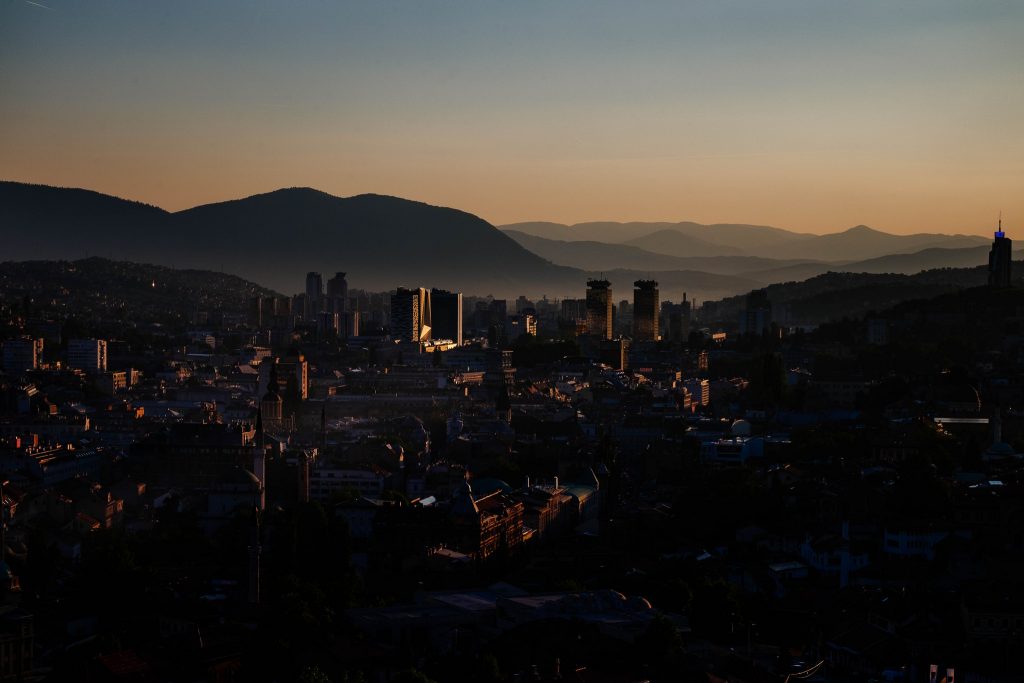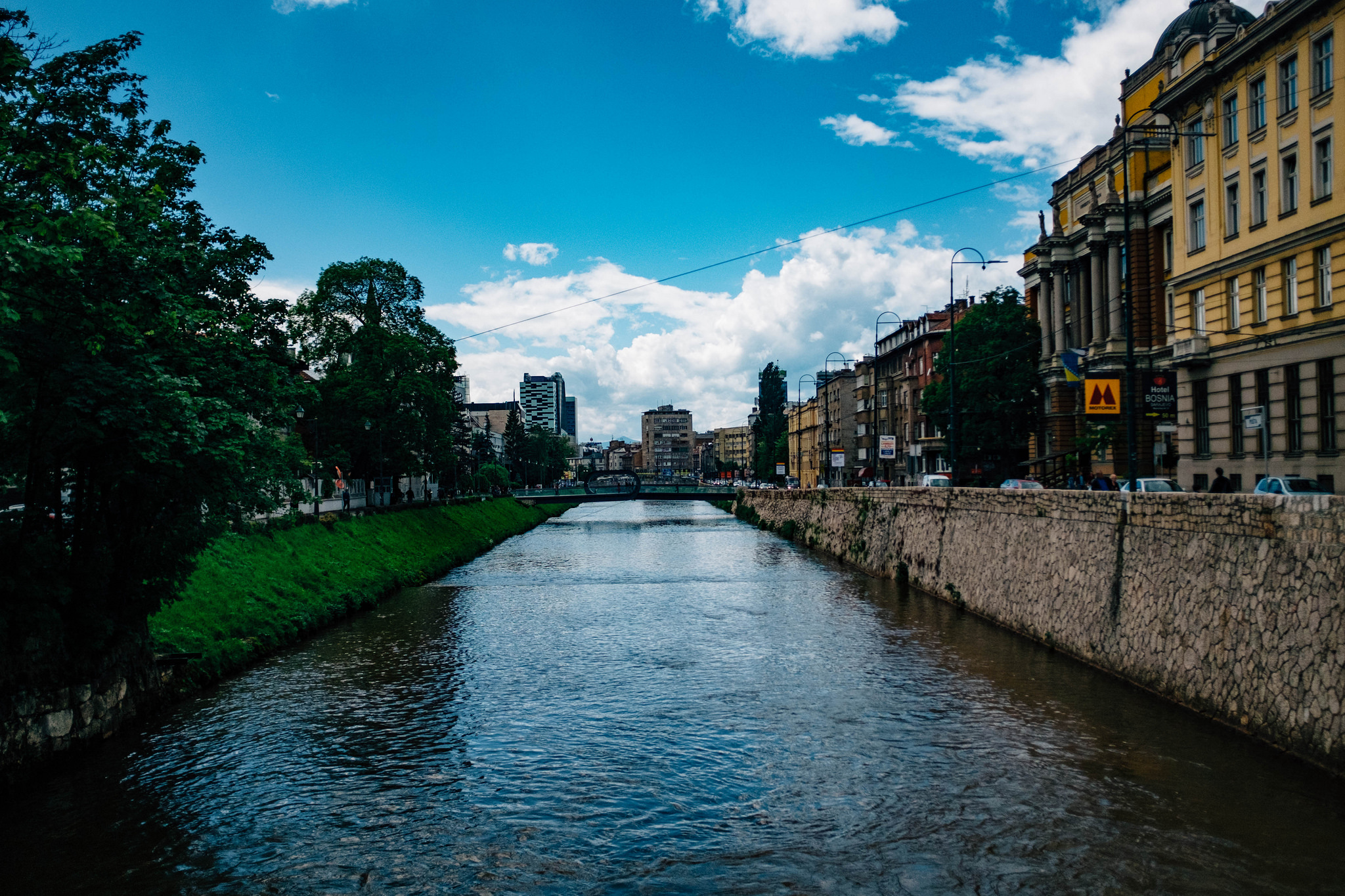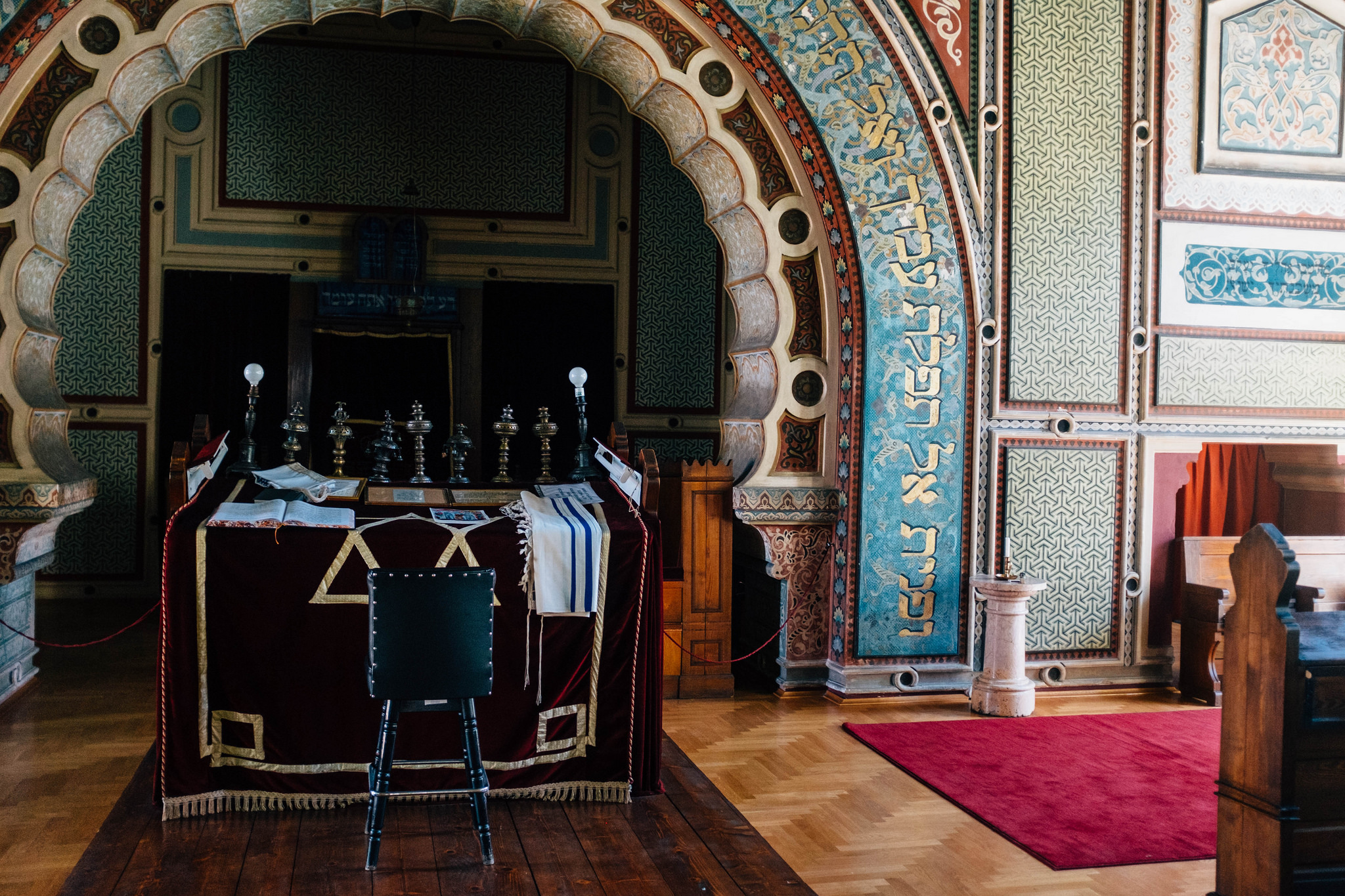
Of all the groups of individuals that have been recognized for their bravery and humanitarian actions during the siege of Sarajevo, perhaps the most effective and far-reaching organization was La Benevolencija.
Of all the groups of individuals that have been recognized for their bravery and humanitarian actions during the siege of Sarajevo, perhaps the most effective and far-reaching organization was La Benevolencija.
Throughout the siege of Sarajevo, the Jewish community provided the city with over 300 meals a day, seven days a week; offered Sunday school for children and language classes for adults; organized cultural activities; and, most notably, coordinated and distributed medical aid free of charge. “It was well-known in the city,” recalls Jakob Finci, President of Sarajevo’s Jewish community and La Benevolencija, with a smile while sitting in his Sarajevo office. “They would say: ‘Go to the Jewish pharmacy! If it’s not there, don’t try,’” he explained.
PCRC intern Anna Bianca Roach sat down with Jakob Finci, one of the city’s most beloved citizens, to get the story behind of one the organizations responsible for saving thousands of Sarajevan lives.
FROM SCHOLARSHIP TO CHARITY
La Benevolencija was founded in 1892, just 14 years after the occupation of Bosnia by the Austro-Hungarian Empire. The occupation brought with it many professional and well-educated Ashkenazi Jews and new connections to Central and Western Europe, which resulted in exceptionally easy access to prestigious institutions of higher education. La Benevolencija was therefore established with the aim to pool resources that would allow a handful of Bosnian Jewish students the opportunity to attend universities in what is today Austria, Hungary, and the Czech Republic where higher education was more internationally recognized and valued.
Judaism has served as a building block of the Bosnian economy since the arrival of the first Sephardi Jewish settlements to Sarajevo in the 15th century. The relatively insular nature of education in the Jewish community, followed by the arrival of Ashkenazi Jews in 1878, made Jews one of the most highly educated groups in the Balkans. Consequently, anti-Semitism in the region was lower than in other areas of Europe. This accepting environment encouraged Jewish students to return to Sarajevo upon completing their studies in institutions such as the University of Vienna, thus contributing to the longstanding success of La Benevolencija
As the group began fostering education in Bosnia, it opened a public library, which would soon become the largest library with the most resources in Sarajevo. However, despite the success of the organization, the rise of anti-Semitism in the interwar years meant the temporary end of operations for La Benevolencija.
SURVIVING THE WORLD WARS
In 1941, Bosnia – along with the majority of the territory that would later become Yugoslavia – fell to the Independent State of Croatia (NDH), which effectively served as a German puppet-state. This government, which included members of the Ustaše – the Croatian Revolutionary Movement who formed a militia and allied themselves with Nazi Germany – led a harrowing Holocaust that decimated the Jewish population in the Balkans. Of the roughly 40,000 Jews who lived within the territories of the NDH prior to 1941, about 9,000 survived WWII – less than one in four. Conservative estimates indicate that one in six Serbs was also killed, as well as at least 16,000 Roma.
In 1945, the end of WWII brought the collapse of the NDH and the establishment of the Democratic Republic of Yugoslavia, soon to become the Socialist Federal Republic of Yugoslavia. At this time, and until the collapse of Balkan socialism in 1991, the region was under a religious ban, meaning that religious organizations such as La Benevolencija were outlawed.
Despite this development, the same group was able to reemerge under the name Sloboda (‘Liberty’) and operated until 1948. After this time, it became clear that Jewish organizations, in particular, were effectively exempt from the ban due to the historical nature of Jewish festivities. Events like Passover and Hanukkah could only be celebrated in ways that could pass as secular. Consequently, the secularized Jewish community was able to continue the cultural, educational, and humanitarian responsibilities of La Benevolencija and Sloboda, this time without an official organizational structure.
The fall of the Berlin Wall in 1991 brought about the collapse of what remained of socialism in the Balkans following the death of Yugoslav President Josip Broz Tito in 1980. That same year, the Jewish community once again revived its humanitarian and educational organization under the name of La Benevolencija for which Jakob Finci was designated as its first official Vice-President. In 1992, just one year after the initiative’s official re-opening following WWII, La Benevolencija celebrated its 100th anniversary.
Just prior to the Bosnian wars, the organization’s primary aim was to share and celebrate the richness and diversity of Bosnian-Jewish culture – the cultures brought to Bosnia by Sephardi and Ashkenazi Jews – as well as the Jewish culture that was produced throughout the centuries of Jewish presence in the Balkan region. However, the rapid rise of tensions in the area, including the war in Croatia and Slovenia that preceded the Bosnian wars, rekindled the group’s interest in humanitarian issues.
BEGINNINGS OF HUMANITARIAN AID
In the lead up to the siege of Sarajevo, La Benevolencija began mobilizing its resources. Its members effectively took on their role as trusted humanitarians of the Balkans when they were mad aware that a small, predominantly elderly community of roughly 35 people in Dubrovnik were unable to access necessary medication because of the disruptions of the war. From this point on, La Benevolencija began stockpiling pharmaceuticals and food with a long shelf life.
Finci explains that the crucial difference between La Benevolencija and other humanitarian organizations operating in Sarajevo during the war was the placement of these stockpiles. Unlike the Muslim, Orthodox or Catholic charities, the Jewish community had no warehouses or storage spaces outside of Sarajevo – consequently, they used their own gymnasium hall in the city proper. When the siege of Sarajevo began in April 1992, virtually every other major charity was cut off from its supplies.
The city’s citizens began looting stores, restaurants, and other sources of food almost immediately, creating a situation in which the Jewish community served as one of the only sources where food and medicine could be found. After a few months, it became clear that the “Jewish pharmacy”, as it was affectionately nicknamed by locals, had an accessibility problem. In order for Sarajevans, living on the north side Miljacka River to reach the pharmacy, located on the south side of the river, they had to cross one of the many bridges that were vulnerable to the hawk-eyed snipers nestled in the surrounding hills.

BECOMING THE SAVIORS OF SARAJEVO
In response to the issue of limited access, La Benevolencija opened a second pharmacy on the north side of the river near the National Theatre. “Even today, it is still a pharmacy,” explains Finci, with a warm smile and a hint of pride in his voice, “that means we found a good place.” The second pharmacy was met with a surge in demand so steep that yet a third pharmacy was opened.
With the successful establishment of not one, but three pharmacies throughout the city operating free of charge, Finci and other leaders of the organization chose to expand the services of La Benevolencija to other sectors.
First, they opened a non-denominational soup kitchen. Under siege, Sarajevo had no source of electricity or warmth – no gas, no coal, no wood, nor anything that could be used for a fire. There was also no access to food once the looted had run out. In response, the soup kitchen began cooking and distributing up to 320 meals a day, 7 days a week.
Second, to help fill the excess time people now had on their hands due to the unemployment caused by the siege, La Benevolencija opened a language school that offered five different language classes, including English, German, French, Hebrew and Arabic.
The organization was also responsible for the reemergence of cultural activity during wartime. 1992 marked the 500th anniversary of the expulsion of Jews from Spain and, thus, of the establishment of Sarajevo’s first Jewish population. La Benevolencija organized concerts and exhibitions at the Holiday Inn marked, which paved the way for other iconic wartime events such as the Miss Sarajevo pageant.
Additionally, La Benevolencija organized a Sunday school. In this time of crisis, hundreds of the city’s children and inhabitants were rediscovering their forgotten (or suppressed) Jewish heritage. In order to embrace newfound members of the community, the Sunday school served to provide them with a means to further their religious education. Finci remembers fondly: “We were able to give [these children] some soft drinks and some cookies from the reserves. And a lot of them said, ‘You know, it’s so nice in this school. May I bring my best friend? Because they’ve spent the last six months in the shelter.’ The answer was yes, and soon we were running a school with twenty Jews and thirty ‘best friends.’”

Lastly, and perhaps most importantly, La Benevolencija organized convoys to evacuate children, elders, and others who wished to escape the war. The trips were initially intended for those members of the Jewish community who, after surviving one war, had no desire to endure another. Soon, however, these convoys became accessible to anyone in the city who wanted to flee. In a historical twist of fate, the Jews’ were not labelled as an official target for persecution by any of the warring factions, and, due to their unique position, they were able to achieve something quite miraculous. Through a series of negotiations, and what Finci describes as seemingly endless paperwork, he was able to obtain authorization for the convoys to pass through the 36 checkpoints that stood between Sarajevo and the Croatian city of Split. Throughout the war, Finci drove 12 convoys, containing upwards of 2,000 Sarajevans of all religions and ethnicities, to freedom.
ACTIVITIES IN TIMES OF PEACE
The first change to La Benevolecija’s structure came as the result of a request by other pharmacies that re-opened after the end of the war that the organization shut down its free pharmacies. The soup kitchen also closed down its operations on Sundays on the condition that a particularly good meal is served on Saturdays at lunch. Finci jokes: “It was well-known in Sarajevo regarding what Shabbat meant. Shabbat was a day with a very good lunch from the Jewish community. And it was crowded every time.”
Following the war, the educational structure and duties of La Benevolencija also changed. Following the economic structure of socialism, and then the disruption of the war, Bosnians were unaccustomed to the proliferation of small businesses. For this reason, the organization began offering courses in business management, which included lessons on how to build a business plan, business management, accounting, and other relevant topics. Shortly thereafter, and with the help of the World Bank, La Benevolencija started granting microcredit and small loans to new entrepreneurs. Along with the courses and the grants that were being offered by La Benevolencija, Sarajevo saw the creation of 3,500 new jobs. This type of loan system is still in place today and is now organized by a foundation called Melacha (the Hebrew word for ‘work’).
Other initiatives have also been established, including Radio La Benevolencija and a community newspaper, which is published five times a year. Both outlets are aimed at sharing available resources, disseminating news and publicizing the cultural events that the organization is in involved in. La Benevolencija also still organizes a Sunday school and supports a Jewish community choir.
THE LONG ROAD TO DEMOCRACY
Despite all the good the Jewish community brought to Bosnia, and despite the strong, ethical, and humanitarian leadership exhibited by Jakob Finci and other members of La Benevolencija, Bosnian Jews are barred from standing for the Bosnian parliament’s upper house or the presidency because they do not belong to one of the country’s three constituent ethnic groups – Croat, Serb, or Bosniak.
In recent years, Finci has attracted international attention for the case he, together with Vice President of the Kali Sara Roma Information Centre Dervo Sejdić, brought to the European Court of Human Rights (ECtHR) denouncing the discrimination towards national minorities that is inherent to the Bosnian constitutional structure created as a part of the Dayton Agreement. The case, which reached the ECtHR’s Grand Chamber in 2009, found the Bosnian Constitution to be in violation of the European Convention on Human Rights due to the ethnic discrimination it propagated. This ruling, however, has yet to come into effect as no action has been taken to bring about the necessary reforms.
To sufficiently describe the profound effect that the Jewish community has had on Sarajevo, and indeed on Bosnia as a whole, would require a historical evaluation of centuries of Jewish cultural, religious, and social history. The story of La Benevolencija, and that of Jakob Finci himself, however, is illustrative of the role that the Jewish community has played in the region. Where would Sarajevo be without the thousands of lives saved as a result of the humanitarian efforts that were undertaken by La Benevolencija? Finci’s humble and down-to-earth manner makes it easy to understate the important and invaluable roles that Jewish culture and leadership have played in the survival and reconstruction of the city’s society.






